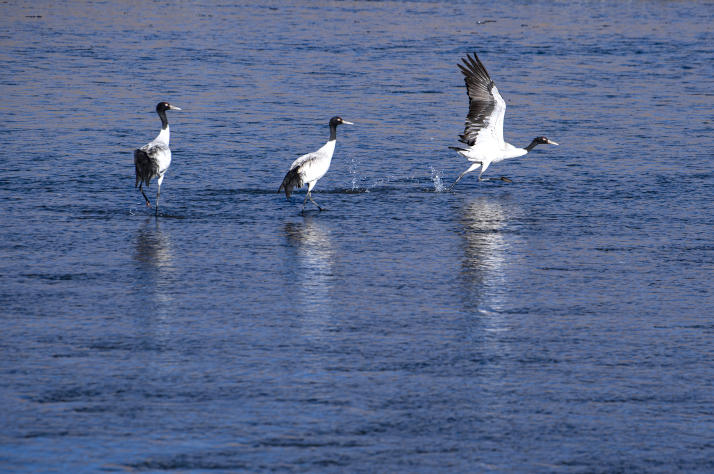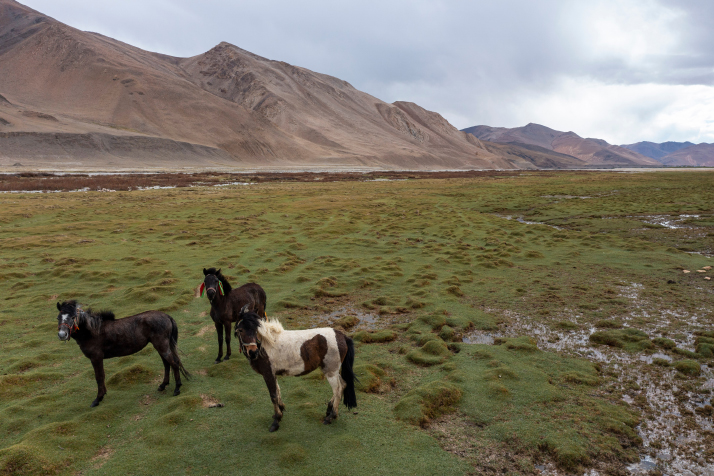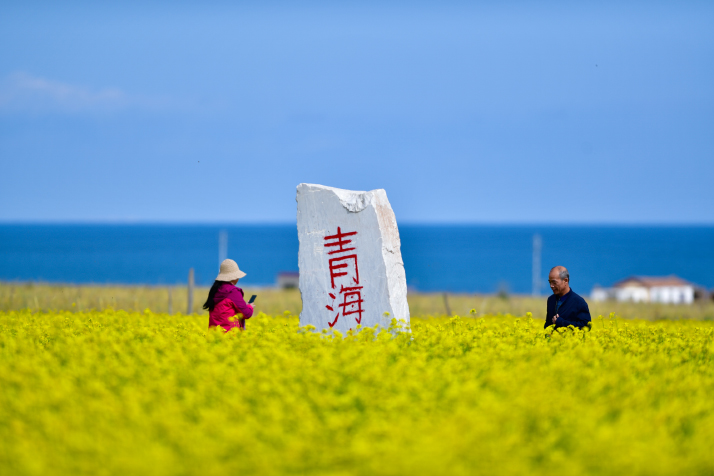
A law to protect the fragile ecosystem of the Qinghai-Tibet Plateau was adopted on April 26 at a standing committee session of the National People’s Congress (NPC), China’s top legislature. It will take effect on September 1.
The Qinghai-Tibet Plateau is known as the Roof of the World, the Third Pole and the Water Tower of Asia. “The plateau is an important shield for China’s ecological security. Therefore, the introduction of the law is of great significance,” said Yuan Jie, head of the administrative law section of the Legislative Affairs Commission under the NPC Standing Committee, adding that the significance of the law goes far beyond the plateau region.
Unique role
The Qinghai-Tibet Plateau is the highest and youngest plateau in the world, with an average altitude of more than 4,000 meters. Stretching 2.58 million square km, it covers not only the entire Tibet Autonomous Region and Qinghai Province, but also parts of four other provincial-level regions in west China, namely Xinjiang Uygur Autonomous Region and Sichuan, Gansu and Yunnan provinces. The plateau is also home to the world’s highest mountain—Mount Qomolangma.
The plateau has abundant sunlight and geothermal resources. Permafrost is widely distributed and the vegetation is mostly natural grasslands. It is home to a large quantity of lakes, the area of which accounts for more than 45 percent of China’s total. Many of its mountains are covered by glaciers and snow.
It is the origin of several large rivers in Asia, including the Yangtze River, the longest river in China and Asia, and the third longest river in the world, as well as the Yellow River, China’s second longest and often referred to as the Cradle of Chinese Civilization.
 Black-necked cranes spend their winters at a nature reserve established for the species’ protection near Xigaze, Tibet Autonomous Region, on January 23 (XINHUA)
Black-necked cranes spend their winters at a nature reserve established for the species’ protection near Xigaze, Tibet Autonomous Region, on January 23 (XINHUA)
The plateau’s fragile ecosystems are now facing a number of challenges from climate change and human activities such as overgrazing, urbanization and road construction.
“Despite having one of the best ecological environments in the world, the natural ecosystem of the plateau is inherently fragile and sensitive,” Chen Haisong, a law professor and specialist in environmental law at Wuhan University’s School of Law, told Beijing Review.
Specifically, the degradation of land on the plateau, including through soil erosion, desertification and deterioration of grasslands, is largely due to rising temperatures. This degradation also affects transportation and living standards in the region through landslides and other geological disasters. Glaciers are continuously retreating and permafrost is thawing, damaging the plateau’s ability to conserve water.
Moreover, habitat damage poses a high risk to the plateau’s biodiversity. “The risk of invasive alien species, including insects, plants and fish, is increasing,” Ouyang Zhiyun, a researcher at the Chinese Academy of Science’s Research Center for Eco-Environmental Sciences, told Beijing-based China Environmental News.
The plateau is a global hotspot for biodiversity research, as it is one of the most biodiverse high-altitude regions in the world. The region has a near complete set of living records of the stages of plant evolution since the Tertiary Period 65 million years ago, making it a key area for studying the evolution and conservation of global plant diversity.
The chiru, or Tibetan antelope, kiang, a type of wild ass, goa, also known as the Tibetan gazelle, and other unique species of wild animals reside on the plateau; with many of them endangered. It is also one of the regions with the highest bird diversity in China, with over 700 bird species, accounting for about half of the total bird species in the country.
 Ponies graze in a wetland in Zhaxizom Township in Tingri County, Tibet Autonomous Region, in May 2022. Zhaxizom is the closest administrative township to Mount Qomolangma (XINHUA)
Ponies graze in a wetland in Zhaxizom Township in Tingri County, Tibet Autonomous Region, in May 2022. Zhaxizom is the closest administrative township to Mount Qomolangma (XINHUA)
Thanks to recent decades of biodiversity protection, the populations of some wild species are growing.
For example, the number of Tibetan antelope, mostly found in the plateau region of northwest China and once a victim of poachers, quadrupled nationwide in recent decades. The status of the animal in China has been downgraded from endangered to near threatened.
Legal backup
“Currently, it is very difficult to overcome the challenges on the Qinghai-Tibet Plateau. For example, once the grassland is damaged, it is difficult to repair,” Chen said. “But what we can do now is take more action to prevent further damage. The new law will ensure that.”
Yuan said the new law on ecological conservation on the Qinghai-Tibet Plateau stresses “prioritizing protection, and letting nature restore itself.”
The law outlines the overall layout of the plateau’s ecological security, stipulates protection and restoration measures, risk prevention and control, and safeguards and supervision.
It prohibits commercial and construction activities that may cause soil erosion in areas that already suffered severe soil erosion or have fragile ecologies. It bans mining activities that do not meet conservation requirements in nature reserves that protect river sources, and imposes strict rules against the construction of new small hydropower stations on the plateau.
More than a dozen endangered or endemic wild animal and plant species, including the wild yak, snow leopard and giant panda, were listed in the law and put under protection. The law also specifies that nature reserves should be established to protect rare, endangered or endemic wild animals and plants to maintain the authenticity and integrity of important natural ecosystems.
This law is a new addition to China’s protection laws for special regions, following the entry into force of the Yangtze River Protection Law on March 1, 2021, the Black Soil Protection Law, to protect this type of soil which mainly lies in northeast China and Inner Mongolia Autonomous Region, on August 1, 2022, and the Yellow River Protection Law in April this year.
China has formed a 1+N+4 framework of environmental laws. “1” is the Environmental Protection Law, the comprehensive and fundamental law; “N” represents specialized laws covering specific types of protection such as water pollution control and wetland conservation; “4” indicates the aforementioned four laws dedicated to special regions.
“Such a framework aims to target challenges from multiple angles, offering a strong legal guarantee for the ecological conservation of such a large country,” Chen said, adding it is expected for the framework to be continuously upgraded as the conditions change with time.
“The laws reflect the long-term commitment to ecological protection,” Dambaru Ballab Kattel, an associate professor of physical geography at the Institute of Tibetan Plateau Research under the Chinese Academy of Sciences, told Beijing Review.
The protection of the Qinghai-Tibet Plateau began a long time before it was codified into law. Relevant State Council departments and each government of the related regions have adopted regulations and plans for protecting the ecological environment and biodiversity, such as Measures of Tibet Autonomous Region on Environmental Conservation Appraisal, and the Action Plan on the Protection of Biodiversity in Northwest Yunnan.
Back in 2018, the State Council Information Office published a white paper titled Ecological Progress on the Qinghai-Tibet Plateau. It read that air quality on the plateau had improved through the promotion of green energy, the progress in building ecological towns and efforts to improve the rural environment.
The paper further said the plateau had, as of publication, established 155 nature reserves, covering an area of 822,400 square km. This is equivalent to over 31 percent of the plateau’s landmass and represents more than 57 percent of China’s land nature reserve areas. “Basically, all of the plateau’s unique and fragile ecosystems and rare species can be found in these reserves,” it said.
 Tourists visit a rapeseed flower field on the shore of Qinghai Lake in Xining, Qinghai Province, in September 2019 (XINHUA)
Tourists visit a rapeseed flower field on the shore of Qinghai Lake in Xining, Qinghai Province, in September 2019 (XINHUA)
Efforts from all
One of the highlights of the new law is that it prohibits travelers from causing damage to the plateau’s ecology. As one of the nation’ most popular tourist destinations, especially for hikers who love to conquer high mountains.
This popularity also brings pollution. “Garbage and feces can be seen along the routes up Mount Qomolangma, which is becoming a huge concern for nature,” Chen said.
Accordingly, the law prescribes penalties for those who litter in the region, stipulating that individuals with serious violations shall be fined between 500 yuan ($72) and 10,000 yuan ($1,440). Visitors should take away the garbage they generate or dispose of it at designated locations. The law also includes provisions for dealing with unruly or uncivil travelers.
Chen suggested local governments should further formulate more detailed regulations and rules based on the new law and based on their specific conditions, as supplements to the law.
“China’s efforts could serve as a model to share in order to protect ecology and the environment in other complex high mountain systems, not only in the Third Pole region but also in the rest of the world,” Kattel said.
The Nepali professor added that cooperation between China and Nepal in recent years has been very helpful in biodiversity conservation, especially through information sharing and actions to combat the smuggling of wildlife and wildlife products, and timber and non-timber forest products.
Kattel calls for further global cooperation in the region, as it is significant not only to sustain the life and livelihoods of the billions of people, but also the habitat of the thousands of species of flora and fauna. “Subtle changes to the ecosystem caused by regional climate warming influence not only the Asian but also the northern hemispheric climate system,” he said. –The Daily Mail-Beijing Review news exchange item





